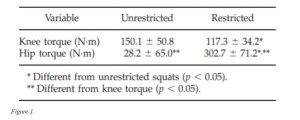One of the best exercises for your lower body and overall health are the squats. However, many people do not know the proper form and put themselves at increased risk of injury when performing this exercise! To this day, people are still told/taught not to let their knees go past their toes during their squats to “protect their knees.” When looking at multi-joint movements like the squat, it is important not to focus on one joint, but to look at all of the joints involved in the movement and how they work together in order to perform the exercise properly and safely. In this blog, we are going to address if it is safe for the knees to go past the toes during your squat.
The idea behind not letting your knees travel forward stems from the idea of reducing stress on the knee joint. It is true that, as the knee travels forward, there is an increased shear force (stress) on the knees. However, as mentioned previously the squat is a multi-joint movement and should be viewed as such. By restricting the forward knee movement, you are forcing the body to bend forward at the hips in order to reach proper depth while maintaining proper weight distribution. This position puts significant stress on the hips/lower back. If you let the knees travel forward however, you are able to keep a more upright position, thus lowering the stress on the hips/lower back!
In the article, “Effect of Knee Position on Hip and Knee Torques During the Barbell Squat,” they did a comparison between the stresses on the knee and hip/lower back in the restricted squats (knees do not go past toes) and unrestricted squats (knees go past toes). You can find the results in the image below (keep in mind that torque is also stress on the respective joint in the table).

From these results, you can see that the stress on the knees does increase slightly when the knees go past the toes, however the stress on the hips/lower back are significantly less. When preventing your knees from traveling forward, you are increasing the stress on your hips/lower back tenfold, putting yourself at risk of injury.
The idea of preventing forward travel of your knees when squatting comes from a study in 1972, “Biomechanical analysis of the knee joint during deep knee bends with heavy load,” which states that increased stress on the knees are associated with forward knee travel during the squat. Although this might be true, the decreased stress on the knees is insignificant when compared to the stress on the hips/lower back by preventing forward travel of your knees.
With all of the research and findings kept in mind, we encourage forward knee movement when performing a squat in order to maintain proper form. When we think of a squat, we think of the ankles, knees, and hips being the prime movers that allow the motion, with the legs and hips musculature to provide the force required to drive you up. With that said, everyone has a different body makeup and different proportions, so everyone’s “optimal” technique is different.
To find out how to perform a proper squat for YOUR body, check out the video below for some tips! For more information on other foundational movements, take a look on our website for more videos here
References
- Ariel B.G. Biomechanical analysis of the knee joint during deep knee bends with heavy load. Nelson R.C., Morehouse C.A. (eds) Biomechanics IV. International Series on Sport Sciences. 1974.
- Fry, A.C., J.C. Smith, and B.K. Schilling. Effect of knee position on hip and knee torques during the barbell squat. J. Strength Cond. Res. 17(4): 629–633. 2003.


